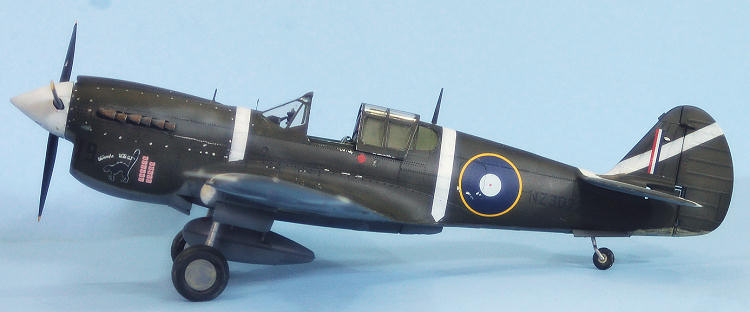
Hasegawa 1/32 P-40M/Kittyhawk III
| KIT #: | 08199 |
| PRICE: | 4600 yen (about $70 MSRP) |
| DECALS: | Two options |
| REVIEWER: | Tom Cleaver |
| NOTES: |

| HISTORY |
The P‑40M was similar to the preceding P‑40K series, with the
primary visual difference being a cooling inlet on each side of the nose ahead
of the exhaust stacks, and a radio antenna mast.
Like the late‑series P‑40K, it was powered by an Allison
V‑1710‑81 engine.
The 600 P‑40Ms produced were almost all destined for
Lend‑Lease, and the airplane was known in the RAF and the Commonwealth Air
Forces with whom it served as the Kittyhawk
The RNZAF and
the Kittyhawk
The RNZAF had its first contact with the Curtiss P‑40 when 80
P‑40E‑1 "Kittyhawk Is" were delivered in April and May 1942.
Number 14, 15, and 16 Squadrons were formed on the
Kittyhawks and undertook training through the rest of the year.
Among the pilots assigned to the first squadron, 14
Squadron, was Flt. Lt. Geoff Fisken, a veteran of the fighting at the beginning
of the war over Singapore, where he served with 243 Squadron and scored 6
victories flying the Brewster Buffalo before being wounded and evacuated in
February 1942.
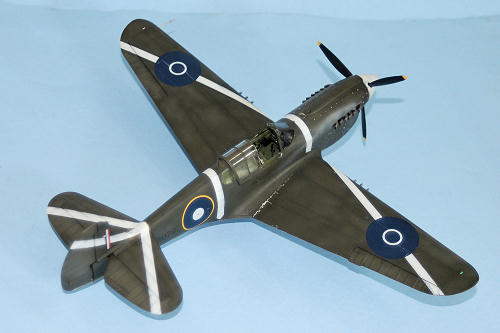 15 Squadron was the first to enter combat on Guadalcanal,
arriving at Henderson field on April 8, 1943, the day after the last great
Japanese raid on the island, in which over 40 Japanese aircraft had been shot
down by the Navy and Marine defenders.
15 Squadron undertook escorts of RNZAF
15 Squadron was the first to enter combat on Guadalcanal,
arriving at Henderson field on April 8, 1943, the day after the last great
Japanese raid on the island, in which over 40 Japanese aircraft had been shot
down by the Navy and Marine defenders.
15 Squadron undertook escorts of RNZAF
The tour of duty for a fighter squadron in the Solomons was six
weeks at a time, and 15 Squadron was relieved by 14 Squadron in early June. 15
Squadron had taken part in the great fighter air battle of June 7, when the
Kiwis claimed four of the 23 Zeros shot down that day.
14 Squadron began its score on June 11, when 25 Zeros
were shot down.
Of the six claims, two were by Flt. Lt. Geoff B. Fisken flying
NZ3072 "Wairarapa Wildcat." Five days later, the largest of the three raids ‑
100 Zeros and Vals from the "Junyo" air group ‑ were intercepted by 74 Allied
fighters; the Kiwis scored five when they dove into a big dogfight over Savo
Island involving 33 Zeros.
With the invasion of New
As the Allied air forces moved into New Georgia and began the
campaign that would end with the invasion of Bougainville in October, the RNZAF
Kittyhawks became the favorites of the Dauntless and Avenger crews to whom they
provided close escort on the Bougainville raids, and later on the missions
against Rabaul once airfields were established on Bougainville in November.
Unfortunately, this role as close escort did not allow
the Kiwi pilots much opportunity to score against the Japanese, who opposed
nearly every mission.
When the Kiwis were released for fighter sweeps on two
occasions during the Rabaul campaign,
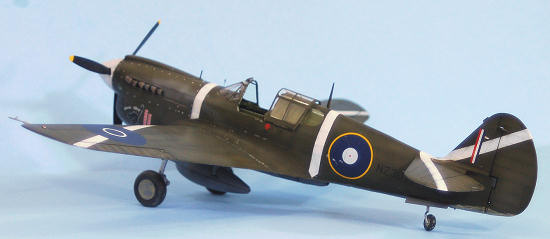 they demonstrated their reputation for
toughness, scoring strongly against the Japanese fighters despite the fact they
were mounted in the "inferior" P‑40.
Following the withdrawal of the IJN fighter units from
Rabaul on
they demonstrated their reputation for
toughness, scoring strongly against the Japanese fighters despite the fact they
were mounted in the "inferior" P‑40.
Following the withdrawal of the IJN fighter units from
Rabaul on
The last RNZAF aerial claim of the war was in February 1944 over
Rabaul, and the total score of the Kittyhawk Wing stood at 99.
That May, the first RNZAF squadron exchanged their
Kittyhawks for F4U‑1A Corsairs, and the Kittyhawk left
“The Wairarapa Wildcat” - the Most Famous Kiwi Kittyhawk:
The “Kittyhawk IIIs ” flown by the RNZAF were actually
USAAF P-40M-5s, which arrived by ship at
Upon arrival in
Originally, the tomcat had no outline, being only a
black figure.
As with many “ace's airplanes,” NZ3072 finally had its day in
front of the cameras in September 1943, when 14 Squadron was set to return to
New Zealand and Fisken had been recognized as the leading Commonwealth ace in
the Pacific Theater.
To aid the photographers, the cats were outlined with
chalk, 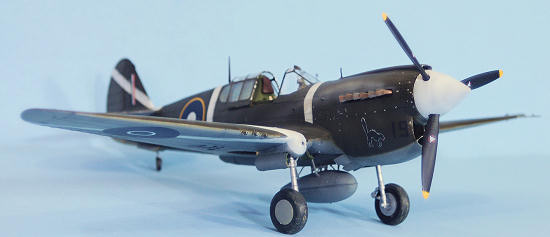 and thus ever since all decals of this famous airplane have been
reproduced with the white outline it that was really only worn one day.
and thus ever since all decals of this famous airplane have been
reproduced with the white outline it that was really only worn one day.
NZ3072 remained at New Georgia after the personnel of 14
Squadron left, and flew operationally with several other squadrons during the
Bougainville and Rabaul campaigns, during which it survived an landing encounter
with a water tanker at Segi airfield.
After surviving its tours of duty, NZ3072 was returned
to
| THE KIT |
This P-40M is the fourth release of Hasegawa's line of
1/32 P40s.
As with the others, it is a scale-up of the excellent 1/48 kits.
The kit differs from the earlier P-40N by having the
parts for the earlier canopy, while utilizing the longer tail part included with
the P-40N.
Decals provide markings for the famous Kittyhawk
| CONSTRUCTION |
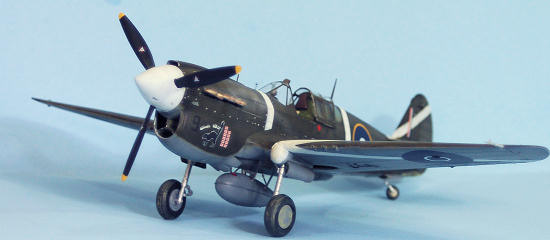 These kits are the essence of simplicity.
I started by painting all the interior parts for the
fuselage with Xtracrylix Interior Green.
While that was drying, I attached the left and right
rear fuselage parts to the respective forward fuselage parts, as well as the
exhaust panels. I then applied a thick coat of Tamiya's “Mr. Surfacer” to the
fuselage joint.
When that was dry, I sanded it smooth and rescribed the panel
lines and the rivet detail.
I also attached the horizontal stabilizers and rudder.
These kits are the essence of simplicity.
I started by painting all the interior parts for the
fuselage with Xtracrylix Interior Green.
While that was drying, I attached the left and right
rear fuselage parts to the respective forward fuselage parts, as well as the
exhaust panels. I then applied a thick coat of Tamiya's “Mr. Surfacer” to the
fuselage joint.
When that was dry, I sanded it smooth and rescribed the panel
lines and the rivet detail.
I also attached the horizontal stabilizers and rudder.
I assembled the interior parts for the radiator, and
then assembled the fuselage, including the aft canopy parts.
I applied Tamiya “Mr. Surfacer” to the centerline seam
and to to the seam around the rear canopy glass.
I then proceeded to assemble the wing.
The wheel wells were positioned and the wing upper
halves and lower wing glued. Fortunately, this time the wing parts were not
“short shot” over the internal structure of the flaps, so I did not have to fill
in and sand those non-existant sink areas.
I attached the guns and applied Tamiya “Mr. Surfacer” to
those joints.
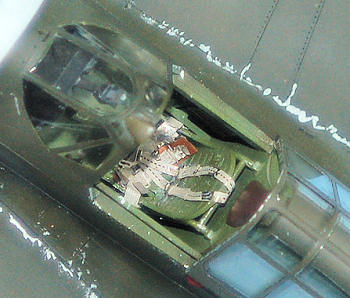 While the fuselage and wing sub-assemblies were setting
up, I assembled the cockpit.
I painted the various detail parts and used the
kit-supplied decal for the instrument panel, but spiffed-up the overall look by
use of the excellent Eduard photoetch seat belts.
The cockpit as supplied looks good enough, though there
is a resin cockpit available now; for me, all that is needed is the seat belts.
My expert on all things Kiwi, Dave Lochead, pointed out
to me that the RNZAF “Kittyhawks” were really USAAF P-40Ms until they were
supplied to the RNZAF, and that they thus used American seat belts, not the RAF
Sutton harness.
While the fuselage and wing sub-assemblies were setting
up, I assembled the cockpit.
I painted the various detail parts and used the
kit-supplied decal for the instrument panel, but spiffed-up the overall look by
use of the excellent Eduard photoetch seat belts.
The cockpit as supplied looks good enough, though there
is a resin cockpit available now; for me, all that is needed is the seat belts.
My expert on all things Kiwi, Dave Lochead, pointed out
to me that the RNZAF “Kittyhawks” were really USAAF P-40Ms until they were
supplied to the RNZAF, and that they thus used American seat belts, not the RAF
Sutton harness.
| COLORS & MARKINGS |
Painting:
Rather than use the decal ID stripes, I painted the area
with Tamiya “Flat White,” then masked those off.
I painted the model overall Olive Drab on the upper
surfaces and Neutral Grey on the lower surfaces after pre-shading the model
along the panel lines.
For the upper color, I started with Tamiya “Olive Drab,”
which is green-base like the early OD used by USAAF aircraft up through 1943,
then went over the panels with Gunze-Sangyo “Olive Drab 2" which is the later
“brown-base” OD, to start fading the colors.
I then added light grey and then white to the paint as I
went back over the panels.
I ended by applying a very thinned coat of Gunze Sangyo
“Olive Drab 2" overall to the model.
I then took some of the green-base OD and “edged”
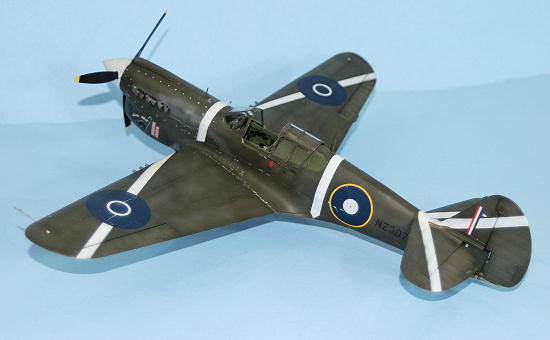 the ID
stripes, since this is commonly considered to be the real color for the “edging”
seen on “Wairarapa Wildcat,” which was the result of the masking tape applied
during the ID stripe painting process.
This may not be that apparent in the photos, but it is
there very subtly in person.
The result looked very close to the photos of the actual
airplane that Dave Lochead pointed me to.
I finished off by painting the spinner white.
When all was dry, the stripes were unmasked and the
model was given two coats of Xtracrylix Gloss varnish.
the ID
stripes, since this is commonly considered to be the real color for the “edging”
seen on “Wairarapa Wildcat,” which was the result of the masking tape applied
during the ID stripe painting process.
This may not be that apparent in the photos, but it is
there very subtly in person.
The result looked very close to the photos of the actual
airplane that Dave Lochead pointed me to.
I finished off by painting the spinner white.
When all was dry, the stripes were unmasked and the
model was given two coats of Xtracrylix Gloss varnish.
Decals:
The decals provide the personal insignia for “Wairarapa
Wildcat” and the RNZAF national markings.
In actuality, the tomcat on the personal insignia was
only “edged” in white with chalk for the one time the airplane was presented to
the press just before Geoff Fisken returned to New Zealand, so - like many
“aces' aircraft” - it is really only right for the one event, like “Marion
Carl's Wildcat”, an F4F hangar queen with Japanese flag stickers on it -
however, in this case Fisken really did fly “Wairarapa Wildcat” for two of his
five Solomons victories.
The decals were a bit thick, and it eventually took applying Solvaset and going over the panel lines with a #11 X-acto blade in order to get them to fully settle on the model.
| FINAL CONSTRUCTION |
I gave the model several coats of Xtracrylix Flat
varnish, then ‘dinged” it lightly with Tamiya Aluminum - photos of the airplane
show it was not all that weathered by the time it got to the end of Fisken's
tour.
The photos also show the grey exhaust stain that comes from running a
lean fuel mixture, which I accomplished with some thinned Tamiya “Sky Grey” with
Tamiya “Smoke” applied over, with the “Smoke” also applied to the lower surfaces
for oil stains.
I finished off by attaching the landing gear and prop,
and setting the canopy in the open position.
| CONCLUSIONS |
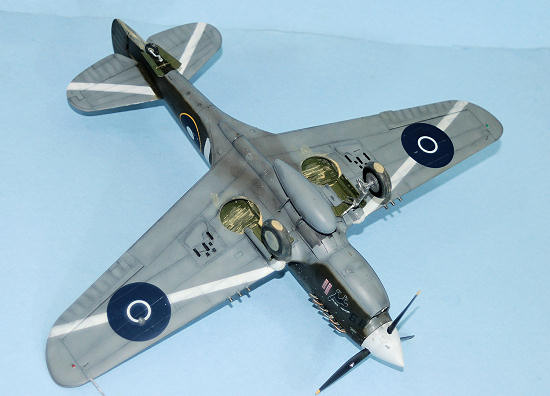
Thanks to HobbyLink
December 2009
If you would like your product reviewed fairly and quickly, please contact me or see other details in the Note to Contributors.